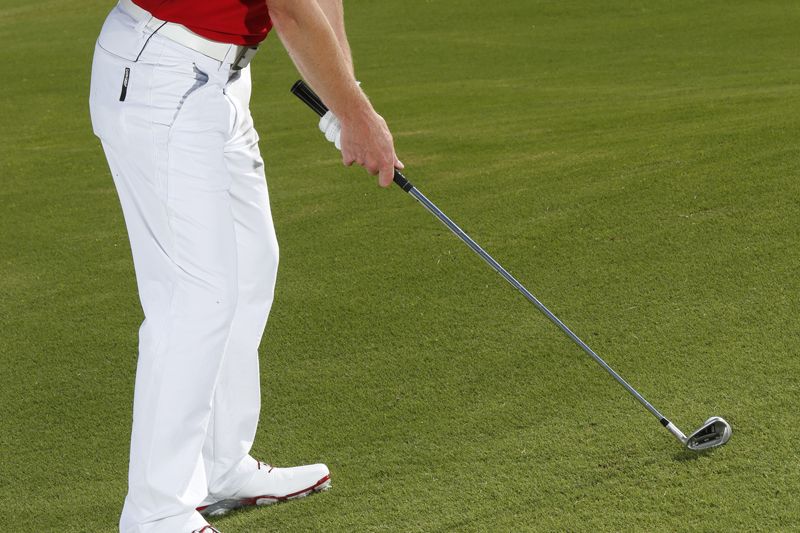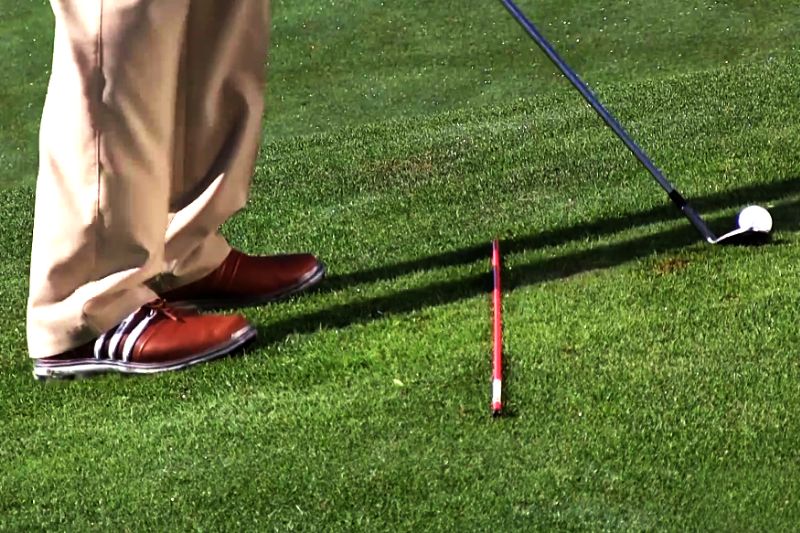Have you ever found yourself in the tricky situation of having to hit a golf ball that’s below your feet? It’s a challenging shot that can throw off even the most seasoned golfers. But don’t worry—by mastering the right techniques and making some key adjustments, you can confidently tackle this shot. In this guide, we’ll explore essential tips and strategies to help you successfully hit a golf ball below your feet, improving your overall game and boosting your confidence on the course.
How to Hit Golf Ball Below Your Feet

When the ball is below your feet, you’re faced with a unique set of challenges. This situation often occurs on uneven fairways or on the side of a hill, where the slope makes it difficult to maintain a normal stance and swing. Here’s a step-by-step breakdown of how to approach and execute this shot.
Understanding the Lie
Before we dive into the mechanics, it’s crucial to understand what happens when the ball is below your feet. This type of lie typically leads to a more open clubface at impact, causing the ball to veer to the right (for right-handed golfers) or left (for left-handed golfers). Knowing this can help you adjust your aim and swing accordingly.
Adjusting Your Stance
The first thing to do is widen your stance. This provides a more stable base and helps you maintain balance throughout the swing. Bend your knees more than usual and lean slightly towards the ball, ensuring you’re positioned securely on the slope. The key is to lower your center of gravity, making it easier to maintain balance and control.
Gripping the Club
With the ball below your feet, you’ll need to grip down on the club slightly. This adjustment helps counter the slope and allows for better control of the clubhead. The amount you choke down will vary depending on the severity of the slope, but a good rule of thumb is to grip down an inch or two.
Swing Path and Clubface Control
Your swing path will naturally be more rounded due to the slope. Focus on maintaining a steady swing plane and avoid any excessive lifting or dropping of your shoulders. The open clubface can cause the ball to slice, so aim slightly left of your target (for right-handed golfers) to compensate.
Follow Through
Maintain a controlled follow-through, ensuring you don’t overcompensate or lose your balance. The slope can make it tempting to stand up too quickly, but focus on staying down through the shot. A smooth, balanced finish will help you stay in control and make solid contact.
Choosing the Right Club for Uneven Lies

The club you choose can significantly impact the success of your shot when the ball is below your feet. Let’s explore some considerations for club selection.
Long Irons and Hybrids
Long irons and hybrids are great options for uneven lies, as their longer shafts and lower lofts make it easier to reach the ball. These clubs also provide more distance, making them suitable for longer shots.
Short Irons and Wedges
Short irons and wedges offer better control and accuracy but can be challenging to use when the ball is below your feet. These clubs require precise ball contact, so be sure to adjust your stance and grip accordingly.
Fairway Woods
Fairway woods can be challenging to hit from uneven lies due to their longer shafts and less forgiving nature. However, they can be effective if you’re confident in your swing mechanics and can maintain control throughout the shot.
Common Mistakes and How to Avoid Them

When hitting a ball below your feet, there are several common mistakes golfers make. Let’s explore these pitfalls and how to avoid them.
Losing Balance
One of the most common issues is losing balance during the swing. The uneven lie can make it challenging to maintain stability, leading to off-balance shots. Focus on a wide stance and bend your knees more than usual to counteract this.
Overcompensating
Another common mistake is overcompensating for the slope, either by aiming too far left or adjusting your swing too much. Remember, the goal is to make minor adjustments, not drastic changes. Keep your setup and swing as close to normal as possible.
Ignoring the Lie Angle
Many golfers forget to consider the lie angle of the club when the ball is below their feet. The club’s lie angle can significantly impact the shot’s direction, so be mindful of this and adjust your aim and clubface accordingly.
The Importance of Practice
Like any aspect of golf, practice is crucial for mastering shots from uneven lies. Here are some practice tips to help you improve your skills.
Practice on Slopes
Whenever possible, practice on slopes to simulate uneven lies. This experience can help you become more comfortable and confident when faced with these shots on the course.
Use Alignment Aids
Alignment aids, such as alignment sticks or a golf club laid on the ground, can help you practice proper alignment and setup. This practice can be especially useful when adjusting your aim for uneven lies.
Focus on Balance Drills
Balance drills can help you maintain stability and control during your swing. Practice swinging with your feet close together or standing on one leg to improve your balance and coordination.
On-Course Strategies for Uneven Lies
When faced with an uneven lie on the course, having a strategy in place can help you execute the shot more effectively. Let’s explore some on-course strategies for hitting a ball below your feet.
Assessing the Lie
Before hitting the shot, take a moment to assess the lie and the slope’s severity. Understanding the conditions can help you make more informed decisions about club selection and shot execution.
Choosing the Right Shot
Depending on the lie and distance to the target, you may need to adjust your shot selection. For example, if the lie is severe and the ball is below your feet, you may opt for a safer, shorter shot to avoid trouble.
Visualizing the Shot
Visualization is a powerful tool in golf. Before hitting the shot, visualize the ball’s trajectory and landing spot. This mental imagery can help you stay focused and committed to the shot.
Mental Approach to Uneven Lies
Golf is as much a mental game as it is a physical one. When faced with a challenging lie, maintaining a positive mindset and focusing on your routine can make a significant difference.
Staying Calm and Focused
Uneven lies can be intimidating, but staying calm and focused is crucial. Take a deep breath, go through your pre-shot routine, and trust your abilities.
Positive Self-Talk
Positive self-talk can help boost your confidence and reduce anxiety. Remind yourself of past successes and focus on the shot at hand.
Accepting the Outcome
No matter how well you prepare, there’s always a chance the shot won’t go as planned. Accept the outcome, learn from the experience, and move on to the next shot.
Equipment Considerations for Uneven Lies
Your equipment can play a significant role in how well you handle uneven lies. Let’s explore some equipment considerations.
Lie Angle Adjustments
Consider adjusting your clubs’ lie angles if you frequently encounter uneven lies. A custom fitting can help ensure your clubs match your swing and improve your performance.
Grip and Shaft Selection
The grip and shaft of your clubs can also impact your ability to handle uneven lies. A comfortable grip and the right shaft flex can improve control and stability.
Golf Shoes
Investing in a good pair of golf shoes with excellent traction can help you maintain balance on uneven lies. Look for shoes with a stable base and good grip.
Golf Drills for Mastering Uneven Lies
Drills can be an effective way to practice hitting shots from uneven lies. Here are a few drills to try.
Downhill Lie Drill
Practice hitting shots from a downhill lie by placing the ball on a slope and focusing on maintaining balance. This drill can help you become more comfortable with uneven lies.
Uphill Lie Drill
Similarly, practice hitting shots from an uphill lie. This drill can help you adjust your stance and swing for uphill lies.
Sidehill Lie Drill
Practice hitting shots from sidehill lies to improve your ability to adjust for different slopes. This drill can help you become more adaptable and confident on the course.
Physical Conditioning for Uneven Lies
Physical conditioning can play a significant role in your ability to handle uneven lies. Let’s explore some exercises and stretches that can help improve your balance and stability.
Core Strengthening Exercises
A strong core can help you maintain balance and control during your swing. Incorporate exercises like planks, Russian twists, and leg raises into your fitness routine.
Balance Exercises
Balance exercises, such as standing on one leg or using a balance board, can improve your stability and coordination. These exercises can help you handle uneven lies more effectively.
Flexibility Stretches
Flexibility is crucial for a full and unrestricted swing. Incorporate stretches for your hamstrings, hip flexors, and lower back into your routine.
The Role of Weather Conditions
Weather conditions can significantly impact how you handle uneven lies. Let’s explore some considerations for different weather conditions.
Windy Conditions
In windy conditions, uneven lies can be even more challenging. Focus on maintaining a steady swing and adjust your aim to account for the wind.
Wet Conditions
Wet conditions can make uneven lies slippery and unstable. Focus on maintaining balance and consider using a less lofted club for better control.
Cold Conditions
Cold weather can affect your flexibility and swing speed. Warm up thoroughly before playing and adjust your club selection and swing accordingly.
Golf Course Management for Uneven Lies
Golf course management can play a crucial role in handling uneven lies. Let’s explore some strategies for managing your way around the course.
Playing to Your Strengths
When faced with uneven lies, playing to your strengths can help you navigate the course more effectively. Focus on shots you’re comfortable with and avoid risky plays.
Avoiding Trouble Areas
Identify trouble areas on the course, such as bunkers or water hazards, and aim to avoid them. This strategy can help you stay out of trouble and improve your score.
Planning Your Approach
Plan your approach to each hole, considering the potential for uneven lies. This planning can help you make more informed decisions and improve your course management skills.
The Importance of a Pre-Shot Routine
A pre-shot routine can help you stay focused and consistent, especially when faced with challenging lies. Let’s explore some components of an effective pre-shot routine.
Visualizing the Shot
Before hitting the shot, visualize the ball’s trajectory and landing spot. This mental imagery can help you stay focused and committed to the shot.
Taking Practice Swings
Take a few practice swings to feel the slope and adjust your balance. These swings can help you become more comfortable with the lie and improve your confidence.
Deep Breathing
Deep breathing can help calm your nerves and reduce anxiety. Take a deep breath before hitting the shot to help you stay relaxed and focused.
FAQs
1. How do I hit a ball below my feet on a steep slope?
On a steep slope, widen your stance, bend your knees more, and grip down on the club. Aim slightly left (for right-handed golfers) to compensate for the open clubface.
2. Should I use a different club when the ball is below my feet?
You may need to adjust your club selection based on the lie’s severity and distance to the target. Longer clubs can help reach the ball, while shorter clubs offer more control.
3. How can I practice hitting shots from uneven lies?
Practice on slopes whenever possible, and use drills like the downhill lie drill and sidehill lie drill to improve your skills. Balance exercises and flexibility stretches can also help.
4. What is the most common mistake when hitting a ball below your feet?
The most common mistake is losing balance and overcompensating for the slope. Focus on a stable stance, minor adjustments, and maintaining balance throughout the swing.
5. Can uneven lies affect the distance and accuracy of my shots?
Yes, uneven lies can affect both distance and accuracy. The slope can cause the ball to veer off course, and improper setup can lead to inconsistent contact and reduced distance.

I am the owner of Ricks Golf Shop, a popular destination for golf enthusiasts. My passion for golf began in my teenage years and has only grown over the years. With over 10 years of experience in the golf industry, I offer expert advice and quality products. With a friendly demeanor and extensive knowledge, I ensure every customer leaves happy.
